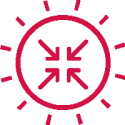
As part of a project to launch a new subsidiary, a telecom operator had structured the various stages of the project into several workstreams: IS, HR, logistics and relocation, governance and organization, data management, finance, etc. These very specific workshops, carried out in parallel, were operating in silos with minimal sharing, coordination, communication and no overall vision.
One year ahead of launch, the challenge for this operator was to secure the launch schedule and to involve its employees in its strategy’s structural transformation.
Our agile coach accompanied this operator on two specific levels:
- Accompany the management committee to help decision-makers create a vision, values, a roadmap and strategic objectives of the future subsidiary.
- Help the workgroups by workstream to deliver iteratively, taking into account the risks and interdependencies between workstreams.
Leverage agile methods to align and stimulate collaboration between sites
This mission's first challenge was to clarify the value proposition of the future subsidiary vis-à-vis its ecosystem and stakeholders, to define in a concerted and co-constructed manner, between members of the management committee, a clear and inspiring vision of the strategic stakes involved in creating this entity.
Once defined, this vision was translated into an operational roadmap to structure the project and its stages.
Upon completion of these tasks, and thanks to the contributions of agile methods, the deployment actions could be defined and launched in an incremental and coordinated way:
- Implement a SAFe-inspired agile governance system to articulate the strategic vision and the deliverables of the projects.
- Define the backlog for the creation of the subsidiary.
- Define the Minimum Viable Product (MVP) for each project.
- Deploy sharing and collaboration tools (Confluence, Jira, Miro, Zoom...).
- Review objectives every 2 months based on the Program Increment Planning (PI planning) model.
To assist the teams in this transformation project, our coach defined and deployed training in agile methods: acculturation, training for PO roles and scrum master.
To ensure proper adoption of agility rituals, personalized support was put in place for easy guidance during the various agile ceremonies.
Towards a sustainable adoption of agile methods
The use of agile methods in this project has been structuring to align all the players and stakeholders of the project on a shared vision and to clarify the roles and responsibilities of each.
This agile framework brought method and rhythm to the iterative and incremental implementation of the project while taking into account the constraints, risks and dependencies between the different projects.
Thanks to the support and guidance of our coach, the teams have adopted new working methods in a sustainable way in which the management committee assumes its leadership role while allowing autonomy to each of the contributors, in order to achieve the set objectives, within a common framework.
A few points of reference on Agility
Scaled Agile Framework (SAFe): an organization and process diagram designed to deploy Agile and Lean methods on a large scale. SAFe attempts to answer the problem of large organizations that wish to have several Agile teams working together. SAFe also aims to deploy Agile and Lean culture and practices throughout the organization, from management to developers.
Program Increment Planning: The PI Planning is probably the most important function of SAFe. It allows to align all the teams of the Agile Release Train (ART) on a common vision and objectives for the duration of an increment (usually 8 weeks to 12 weeks).
Agile Release Train (ART): ART is a group of multiple Agile teams that come together to develop and deliver specific solutions. The train typically includes between 50 and 125 people who work together to develop and deploy these solutions.





